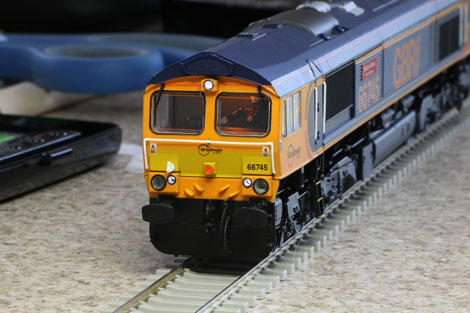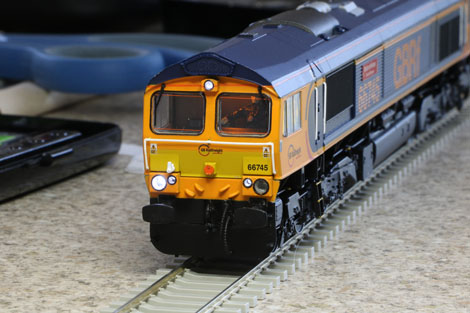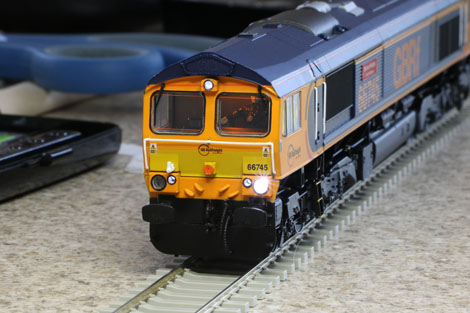
|
First DCC sound installation using the new Bif ESU LokSound V5. The test vehicle is my Bachmann Class 66 number 66745
|

|
Some personal views on UK sound project recent DCC sound decoder history: 66745 was fitted with a Bif V4 LokSound decoder back in 2014. Not long afterwards, Zimo brought out a number of improvements, used successfully by Paul Chetter, to create sound systems that enabled much more realistic simulation of heavy load diesel electric locomotive starting behaviour & braking. Zimo decoders also include far more function outputs than LokSound V4, permitting far more comprehensive lighting control, without the need for an additional function decoder. Consequentially the next three 66s in the fleet received a very effective Zimo fit...... Bif's LokSound v4 incorporating Drive hold and dynamic braking then arrived, to give Zimo some meaningful Diesel Electric competition (albeit with a supporting LokPilot FX function decoder on board). As now fitted to my most recent Freightliner 66. However, ESU's LokSound V5 has now more than made up the ground originally lost to Zimo, introducing further improvements in driving functionality, combined with at least an equivalent complement of function outputs to Zimo, but under the control of the very capable ESU mapping arrangements, which I find rather more capable than the Zimo "Swiss mapping" technique. The V5 also includes a more comprehensive optimisation of the back emf motor control system than either Zimo or LokSound V4, which may prove useful in taming difficult motor characteristics. |
|
A revised Lighting Spec. to make good use of all those new function outputs:
6) Key (24): H/L-2 + R/L-2 + Aux1-2 + Aux2-2
|
|
Modifying the hardware:
Quite a few minor adjustments were needed to modify the original circuitry to greatly improve the lighting functionality and to add a supercap stay-alive system. Although most function outputs are available via the 21 pin connector, only 4 of these are normal "power" outputs, the rest (Aux3 upwards) are logic level, which require inverting buffer amps to drive lighting LEDs. However outputs Aux3 to Aux8 are also available as "power" output solder pads along the rear edge of the decoder. As I already had two FET buffers fitted to the board, I used these for Aux3 and Aux4, and hard wired to Aux5, 6, 7 and 8 solder pads.
The Stay alive circuit uses a zener diode to protect the supercap from excessive charging voltage in case the loco is ever used on a higher voltage DCC system. The access wires (ground and Common Positive) were also taken from the rear solder pads for convenience (although these are also present on the 21 pin connector).
|
|
Circuit Diagram:
|
 Yard mode front marker lights
|
 Normal day time front running lights
|
 Normal night time front running lights |
 Rear lights |
|
New Function Output Arrangement Conclusions: What a dramatic improvement on the V4! All the flexibility of the excellent V4 mapping system, combined with up to 12 Function outputs! There will not be many applications that cannot be handled now by the additional on-board function output capability! I guess the down side for ESU will probably be a reduction in sales for the LokPilot FX 6 x FO function decoder!
|
|
The New Driving Environment: Changes between V4 and V5 include 5 speed characteristics selectable using the LokProgrammer, but with the omission of traditional 3 point CV settings (except in V5 DCC, only available in the US & Australian markets). Drive hold continues to be available and seems to work well. A user programmable 3 key selectable braking system is provided for users wishing to use high train momentum CV4 values. Two user programmable alternative train load simulation modes are also key selectable. These alter both CV3 and CV4 to simulate extra heavy trains.... or lighter train loading.
1) Speed Control Characteristic This is a contentious area, as the new arrangements make it very tricky to exactly reproduce an existing V4 3-point speed control characteristic for mixed V4/V5 consisting purposes. That is, unless you manage to source the DCC only V5 LokSound variant, currently restricted to sales in the U.S. and Australia (which includes a 3 point option)....... New V5s on sale in Europe specifically exclude a 3 point set-up and instead provide 5 pre-programmed 28 point speed control mapping via the LokProgrammer, with a default exponential set-up. The obvious question is why is the DCC only variation not also available to UK users ???? However, the above is less of a problem if the user is prepared to copy the V5 characteristic into co-consist V4 devices, which I have just successfully done, using the LokProgrammer..... or use a linear control characteric. Personally I prefer the extended low speed region provided by the default exponential 1 option, and will proceed initially using this. 2) Braking options Up to 3 keys can be programmed to provide a progressive braking action. So far I've just tried to use a single key (brake 1) and I've now mapped this to operate if keys 5,15 or 25 are pressed so whichever keyset is presented, you just have to hit the "5" to brake the loco. I've also set these Lenz control keys to press button operation when using this loco. 3) Train load simulation options Two keys can be programmed to provide alternative locomotive behaviour, simulating the effect of different train loads on locomotive performance, by simultaneously altering CV3 and CV4. So far I've set one key to simulate light engine and the other, a maximum weight freight train. 4) Drive Hold Drive Hold is still included as a "sound function" and is invaluable for briefly delaying the locomotive departure, while the engine power increases sufficiently to start a heavy train. This makes Diesel Electric operations feel much more like the real thing. 5) Additional motor optimisation controls Additional adjustments to the back emf motor control system are provided, to give a few more possibilities to deal with problem motors. My test Bachmann 66 works well with fairly normal values. |
| 66745 Active Button
Assignments:
Motor Control Settings
|
|||||||||||||||||||||||||||||||||||||||||||||||||||||||||||||||||
Next comes operational testing on the PC controlled test track with the customary video to demonstrate how the new loco behaves.
|
Bachmann 66 wobble: The video shows a distinct side to side wobble as the 66 negotiates the loft layout tracks. Placing the locomotive on a rolling road, the effect is quite apparent. Tightening up the bogie fixing screws had no effect. Looking carefully at the rotating wheels on the rolling road revealed that the wheel set nearest the coupler on each bogie seemed to be responsible. The movement suggests a slightly off centre wheel axle could be the cause. However, dismantling one of the bogies, suggested an alternative mechanism. As the wheels are driven round, there seems to be a lateral movement of the coupler end wheel set. The wheels move from side to side as they are driven round by the gear train. The slightly conical nature of the wheel tyre surface (increasing in diameter very slightly towards the flange) results in a regular pattern of tiny differential vertical movements between the lead left and right hand wheels, possibly creating the wobble........ A fix maybe achieved by limiting the side play of the problem wheel sets........ nope, tried that...still wobbles! A quick check on three earlier non-sound fitted Bachmann 66s showed that two out of three also exhibited the rocking motion...... So I have performed a bogie swap between the one good runner and 66745....... successful! I tried restricting the side play on the outside wheel sets of both bogies re-fitted to the old 66 to see if that helps combat the problem..... nope-still wobbles! Better check the 3 Zimo 66s for these symptoms.... and I'll also update the firmware to try out Zimo's variation of drive hold for comparison! ..... but that's another story! |
|
A Third Bif LokSound 66: The last of my early non-sound fitted 66s was a stroke nine GBRF unit with an early, now obsolete livery. This locomotive had a rock steady chassis without any hint of the wobble discovered in several of the other early Bachmann 66s. I decided to pair up the very stable GBRF chassis with the still current upper body shell from my very wobbly (but otherwise still good looking) early Freightliner 66/9 unit, and then fit a Bif V5 sound system. First job was to fit a speaker..... I hoped to utilize a 4 ohm double sugar cube speaker, but there is not room for one of these in the preferred fuel tank location.... so instead I fitted my well proven ESU 40x20mm elliptical shaped conventional speaker, inverted within the fuel tank and added an air sealed enclosure incorporating a recess for the motor, which protrudes into the top of the fuel tank moulding.
The new speaker installation. The LokSound V5 provides a good solution to control a comprehensive 66 lighting fit. The 4 dual purpose function outputs and the large number of additional full power outputs, enable the desired functionality to be achieved without any additional hardware (except for the new LEDs and their series resistors) and I prefer the very flexible ESU function mapping arrangements to the equivalent Zimo Swiss mapping scheme.
The loco, re-wired ready to begin fitting the new decoder and stay alive parts. Bif's V5 will be supported by a 17000uF 15V stay alive supercap sourced from YouChoos (with zener diode max. charging voltage limiter). Initially the detonator flash LED will not be fitted to this model, but I may add one later (driven via Bif's very effective LED drive output on Aux3.)
Proposed Circuit Diagram. As can be seen in the circuit diagram above, no extra buffer transistors are required, thanks to the extra full power function outputs included on the new V5 LokSound. However, Aux outputs 3 to 8 are only available as power outputs on the array of solder pads at the end of the LokSound V5 module, so these will have to be hard wired between the decoder module and the locomotive circuitry. For convenience, the stay alive connections will also be derived in the same way.
The stay-alive circuit, now added behind the driver.
Hard wired V5 decoder type 58419 connections for this project are shown in red. (Aux3 will not initially be used, but if I later fit a detonator flash LED plus series resistor, this FO will drive them.)
The new decoder wired in. Bif version update: The Freightliner V5 is fitted with the "Bif version 18A" sound project..... The most apparent difference between V5, Bif version 18 (in GBRF 66745) and 18A, is that 18A arrived with a linear speed characteristic whereas 18 had the V5 default exponential 1 characteristic, which I like, as it expands the slow speed region. So I promptly re-programmed the Freightliner characteristic to exponential 1.
Ready for the first DCC test....... oops lighting needs a few mapping tweaks!
The Freightliner hardware connections are slightly different to those of the earlier GBRF loco. The lights consequentially operate much better with the above mapping adjustments. :-)
|
|
Slow Speed Motor Control differences between V4 and V5: The Bachmann 66 is normally a very non-critical loco to optimise for best BEMF behaviour using V4. The V4 slow speed adjustments are typically CV51 = 0 to 2, while CV52 = 30 to 45. However this type of entry on the Freightliner V5 resulted in very jerky low speed behaviour. Better results seem to be obtained with CV51 much higher at circa 12 and CV52 somewhat higher at 50+. When all else fails....read the instructions: The V5 manual indicates a different adjustment purpose for CV51 than that described in the V4 manual, with a suggestion that CV52 should be set to circa 10 higher than CV54, while CV51 now adjusts the transition point in the speed curve between slow speed settings and the rest. After a bit of experimenting, I've ended up with driving & motor settings for the elderly Freightliner 66/9 close to those the earlier GBRF V5.
|
|||||||||||||||||||||||||||||||||||||||||||||||||||
| Supplier website links:
|